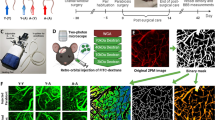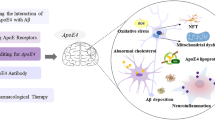Summary.
An animal model of graded cerebral hypoperfusion achieved by way of 2- and 4-brain vessel occlusion (vo) was used to test the effect of chronic propentofylline (PPF) administration on hippocampal energy state and amyloid precursor protein (APP) concentration. For this purpose, forty adult rats were subjected to stepwise and permanent 2 vo and 4 vo and PPF in a dose of 25 mg/day per kilogram body weight was continuously administered intraperitoneally for 1 week or 3 weeks, respectively. During the final steady-state experiment arterial blood parameters and blood gases (mean arterial blood pressure, pO2, pCO2, pH, hematocrit, hemoglobin, body temperature) were measured. Brain tissue concentrations of adenosine triphosphate (ATP), adenosine diphosphate (ADP), and adenosine were measured in rat hippocampus by high-pressure liquid chromatography (HPLC) analysis; APP concentration was determined using Western blot techniques. In adult rat brain, long-term PPF treatment induced a striking increase in hippocampal ATP concentration which was paralleled by an enhancement of the ATP/ADP-ratio. Specifically, after 2 vo with 1 week of PPF treatment the ATP concentration in hippocampus was enhanced by 18% when compared with 2 vo without PPF treatment, whereas after 3 weeks PPF administration with 4 vo the concentration of ATP was enhanced by 31%. Furthermore, PPF reduced the tissue concentration of adenosine from 17.75 ± 2.79 to 8.83 ± 3.68 pmol/mg wet weight during 4 vo if compared with animals without PPF. In addition, the APP concentration was enhanced by 35% after 1 week PPF administration when compared with non PPF treated animals. In summary, the results demonstrated that chronic administration of PPF induced an enhancement in ATP concentration in adult rat hippocampus under conditions of long-term brain vessel occlusion. Interestingly, 1 week PPF seems to have a stimulating effect on APP which may act neuroprotectively. Thus, PPF may protect hippocampal neurons from chronic ischemic damage. In conclusion, PPF may have some beneficial effects and could be used in the treatment of patients with chronic cerebrovascular disorders or neurodegenerative diseases such as vascular dementia.
Similar content being viewed by others
Author information
Authors and Affiliations
Additional information
Received December 12, 1997; accepted February 19, 1998
Rights and permissions
About this article
Cite this article
Plaschke, K., Martin, E. & Bardenheuer, H. Effect of propentofylline on hippocampal brain energy state and amyloid precursor protein concentration in a rat model of cerebral hypoperfusion. J Neural Transm 105, 1065–1077 (1998). https://doi.org/10.1007/s007020050112
Issue Date:
DOI: https://doi.org/10.1007/s007020050112




